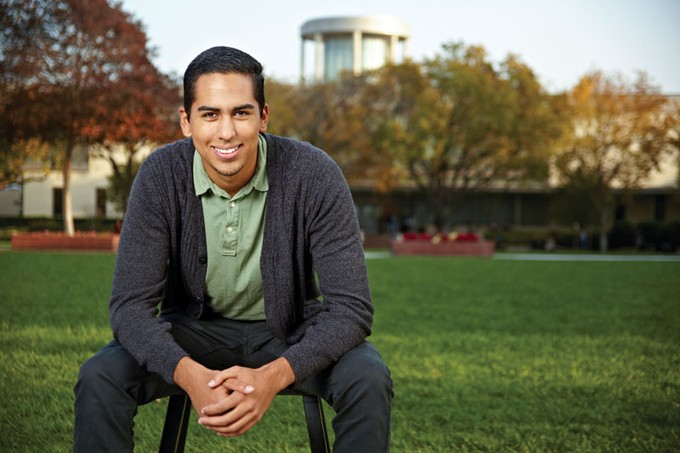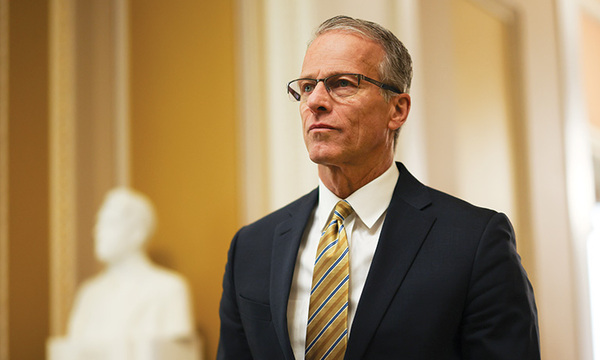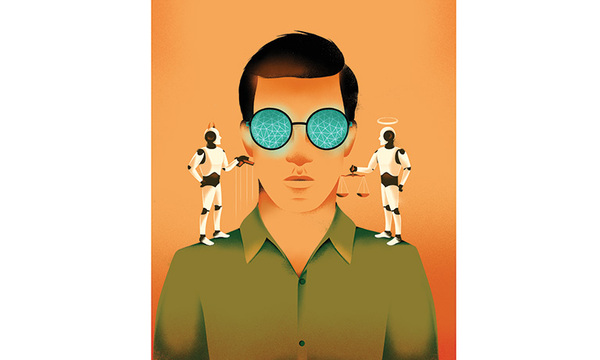
Jose Anaya (’14) was born in Colombia and grew up in the town of Barranquilla, where his father worked for the government as a veterinarian for large livestock. At age 9, Jose and his family were forced to leave Colombia as persecution from local insurgents escalated, and so the family moved to Downey, Calif. Since then, Jose’s parents have both had to take minimum wage jobs to help support the family, and money has always been tight.
Jose knew paying for college was going to be tough, but he desperately wanted to attend a Christian college. He fell in love with the Biola community after attending events on campus and meeting with admissions counselors, but his family was $9,000 short of being able to afford Biola, even after scholarships and loans. All Jose could do was pray.
Amazingly, the prayers were answered. Biola’s financial aid office was able to award him an additional $1,000 scholarship, and then he found out his church wanted to raise money for him. One Sunday the pastor called Jose up to the front and as he stood there, people came forward and donated money for Jose’s education. Seven thousand dollars worth. With Biola’s church-matching scholarship, Jose had everything he needed to pay for his freshman year.
The affordability struggle continued throughout his four years, but Jose made the most of his time at Biola as a business major. President Barry H. Corey, whom Jose had gotten to know, wrote a letter that helped him get accepted into a Nestle symposium for leadership development, and Harold Taber, a former president of the Coca-Cola Bottling Co. of Los Angeles, mentored him.
Now a Biola alumnus, Jose and his wife, Addie (Stephens, ’14), live in the San Francisco Bay Area where he works as a market development manager for Coca-Cola.
Because of the scholarships, donations and generosity of so many friends, family and Biola supporters, Jose’s life was transformed at Biola.
“My story is mostly about hope,” Jose said. “Hope in what God did and what God is going to do. I have been often criticized for school and the cost, but I have been challenged to stand up and say, ‘This is where God placed me.’ To see him provide in the face of that has been exciting and humbling.”
Every year, hundreds of students like Jose dream of completing a degree at Biola. But for many of them, the financial struggle to pay tuition bills from semester to semester is a burden that makes the dream difficult, if not impossible. Each semester, some Biola students are forced to transfer or take time off because they can’t afford to stay. That’s a scenario Biola desires to eradicate over the next decade as taking on the challenge of affordability becomes priority No. 1.
Tackling a Crisis
Affordability is one of the most critical issues facing American higher education. Simply put, the average cost of a four-year education is getting so high, and subsequent loan debt so burdensome, that some families are questioning the value of the investment. Is a college degree worth $28,000 in debt? That’s currently the average amount of debt for bachelor’s degree recipients at private nonprofit institutions.
Debt has sadly become the “accepted norm” of higher education — 69 percent of students at private universities graduate with it — thanks in part to a steep ascent in higher education price tags in recent decades. Between 2000 and 2010 alone, prices at private four-year institutions rose 31 percent, after adjustment for inflation.
The ballooning of student loan debt is alarming. A report by the U.S. Education Department and the Consumer Financial Protection Bureau estimated that total outstanding student loan debt surpassed $1 trillion in 2011. The growing need for student loans has also led many students to take out private loans, which often have higher interest rates than government loans and are harder to discharge in bankruptcy. In 2011, cumulative defaults on private student loans exceeded $8 billion.
Adding to the challenge for many college graduates is the stark reality that fewer jobs await them after graduation. With debt repayment looming large, many graduates take jobs in fast food or retail simply to get by.
Human biology graduate Evan Thibodeau (’11) received as much financial aid as was possible during his time at Biola, but it was still not enough to cover the cost of attendance.
“I have always had a job, but finding a job that pays enough to eliminate my debt is hard. I have to pay $600 each month for my loans,” said Thibodeau, who at one point had to work two jobs at Starbucks and Subway in order to pay his debt loans. “Still, I would not have done anything different. There are so many tangible ways God has used Biola to transform who I am to change the world for Christ.”
In order for Biola University to live up to its calling to educate and send forth Christian workers for world impact, the “perfect storm” of rising education costs, inflation, debt and a stagnant economy must be addressed with a comprehensive plan.
In spite of Biola’s extensive efforts to help students financially the needs are still great. Available scholarship support is currently woefully inadequate to meet the increasing needs of Biola students. The university continues to lose quality students who deeply desire the kind of education provided at Biola — unique in its biblically centered focus on the liberal arts — but who cannot make it work financially to attend.
To combat this issue, Biola has dedicated nearly half — $85 million — of its comprehensive campaign to the area of scholarships.
“We’ve set this ambitious goal because we want Biola to be a place where students leave with knowledge and wisdom rather than crippling debt,” said Adam Morris, vice president for advancement. “We want Biola to be within the reach of any and all students seeking a biblically centered education, not just the ones from the highest family income brackets.”
As U.S. College Tuition Rates Have Risen...
Across the nation, university costs have skyrocketed over the past four decades. Between tuition, fees, room and board, students at private four-year schools are paying more than $42,000 today for what they paid just $17,000 (adjusted for inflation) in 1971.
...So Has Student Debt
Between 1993 and 2012, the average total debt in the U.S. for graduating seniors with student loans grew from $9,450 to $29,400.
What Biola is Doing to Be More Affordable
Biola currently has numerous efforts and programs aimed at making the university more affordable for students.
More than $30 million is distributed each year to Biola students in the form of direct scholarship assistance.
About 84 percent of Biola students receive some form of student aid.
More than 140 endowed scholarship funds have been established to help students at both the undergraduate and graduate levels.
In each of the past few years, Biola’s annual tuition increases have been kept to historically low rates, including 3.6 percent last year.
Biola is educating students and families about stewardship and student debt, including a seminar for parents during opening weekend, classes on “Faith and Money” and mandatory loan counseling for students.
The percentage of total tuition revenue that is returned to needy students in the form of scholarships has increased each year, currently at 26.3 percent. In order to do this, the university has reduced expenses in other areas.
Biola recently instituted friendlier student payment plan options, reducing the amount required at the start of the semester from 60 percent to 50 percent. This helps students with low cash flow who may otherwise resort to high-interest credit cards for their down payments.
What Biola Will Do to Be More Affordable
To ensure affordability, the university has outlined several key initiatives for the next few years.
1. DISTRIBUTIVE LEARNING. New online, off-site and hybrid programs will not only expand Biola’s educational reach but will provide new revenue sources and potentially provide coursework at reduced rates, both of which will have a positive impact on affordability.
2. EFFICIENCIES IN COURSES/MAJORS. Biola will assess its academic and co-curricular programs to ensure that the university is running at optimal efficiency.
3. ACADEMIC CALENDAR. For those students who desire to speed up their degree progress, a number of ideas are being explored, including a greater use of the campus for classes in the summer and plans for three-year degree programs.
4. BIOLA LOAN PROGRAM. Biola will consider expanding its loan program in order to offset deteriorating loan options in the marketplace. Biola loans could possibly be offered at a rate that would be favorable for both students and the university.
5. JOB PLACEMENT/INTERNSHIPS. Affordability has a direct relationship to a student’s ability to get a job after graduation in their preferred field, at a salary that will allow for a reasonable payback of student loans. Biola will explore ways to bolster its job placement and internship programs to put our students in a better financial position upon graduation.
 Biola University
Biola University



